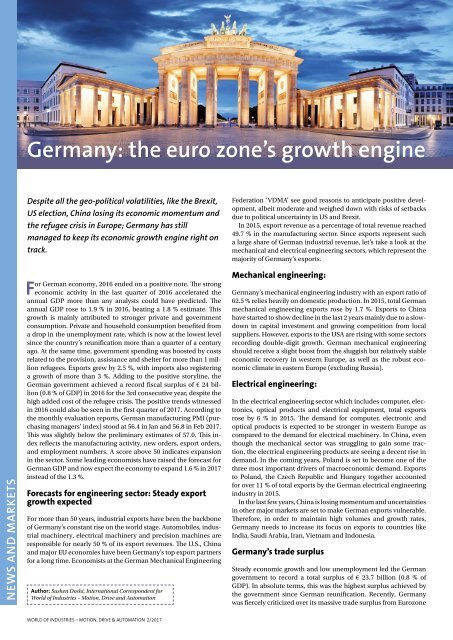WORLD OF INDUSTRIES - MOTION, DRIVE & AUTOMATION 2/2017
WORLD OF INDUSTRIES - MOTION, DRIVE & AUTOMATION 2/2017
WORLD OF INDUSTRIES - MOTION, DRIVE & AUTOMATION 2/2017
- TAGS
- mda
- automation
- industries
Create successful ePaper yourself
Turn your PDF publications into a flip-book with our unique Google optimized e-Paper software.
Germany: the euro zone’s growth engine<br />
Despite all the geo-political volatilities, like the Brexit,<br />
US election, China losing its economic momentum and<br />
the refugee crisis in Europe; Germany has still<br />
managed to keep its economic growth engine right on<br />
track.<br />
Federation ‘VDMA’ see good reasons to anticipate positive development,<br />
albeit moderate and weighed down with risks of setbacks<br />
due to political uncertainty in US and Brexit.<br />
In 2015, export revenue as a percentage of total revenue reached<br />
49.7 % in the manufacturing sector. Since exports represent such<br />
a large share of German industrial revenue, let’s take a look at the<br />
mechanical and electrical engineering sectors, which represent the<br />
majority of Germany’s exports.<br />
NEWS AND MARKETS<br />
For German economy, 2016 ended on a positive note. The strong<br />
economic activity in the last quarter of 2016 accelerated the<br />
annual GDP more than any analysts could have predicted. The<br />
annual GDP rose to 1.9 % in 2016, beating a 1.8 % estimate. This<br />
growth is mainly attributed to stronger private and government<br />
consumption. Private and household consumption benefited from<br />
a drop in the unemployment rate, which is now at the lowest level<br />
since the country’s reunification more than a quarter of a century<br />
ago. At the same time, government spending was boosted by costs<br />
related to the provision, assistance and shelter for more than 1 million<br />
refugees. Exports grew by 2.5 %, with imports also registering<br />
a growth of more than 3 %. Adding to the positive storyline, the<br />
German government achieved a record fiscal surplus of € 24 billion<br />
(0.8 % of GDP) in 2016 for the 3rd consecutive year, despite the<br />
high added cost of the refugee crisis. The positive trends witnessed<br />
in 2016 could also be seen in the first quarter of <strong>2017</strong>. According to<br />
the monthly evaluation reports, German manufacturing PMI (purchasing<br />
managers’ index) stood at 56.4 in Jan and 56.8 in Feb <strong>2017</strong>.<br />
This was slightly below the preliminary estimates of 57.0. This index<br />
reflects the manufacturing activity, new orders, export orders,<br />
and employment numbers. A score above 50 indicates expansion<br />
in the sector. Some leading economists have raised the forecast for<br />
German GDP and now expect the economy to expand 1.6 % in <strong>2017</strong><br />
instead of the 1.3 %.<br />
Forecasts for engineering sector: Steady export<br />
growth expected<br />
For more than 50 years, industrial exports have been the backbone<br />
of Germany’s constant rise on the world stage. Automobiles, industrial<br />
machinery, electrical machinery and precision machines are<br />
responsible for nearly 50 % of its export revenues. The U.S., China<br />
and major EU economies have been Germany’s top export partners<br />
for a long time. Economists at the German Mechanical Engineering<br />
Author: Sushen Doshi, International Correspondent for<br />
World of Industries – Motion, Drive and Automation<br />
Mechanical engineering:<br />
Germany’s mechanical engineering industry with an export ratio of<br />
62.5 % relies heavily on domestic production. In 2015, total German<br />
mechanical engineering exports rose by 1.7 %. Exports to China<br />
have started to show decline in the last 2 years mainly due to a slowdown<br />
in capital investment and growing competition from local<br />
suppliers. However, exports to the USA are rising with some sectors<br />
recording double-digit growth. German mechanical engineering<br />
should receive a slight boost from the sluggish but relatively stable<br />
economic recovery in western Europe, as well as the robust economic<br />
climate in eastern Europe (excluding Russia).<br />
Electrical engineering:<br />
In the electrical engineering sector which includes computer, electronics,<br />
optical products and electrical equipment, total exports<br />
rose by 6 % in 2015. The demand for computer, electronic and<br />
optical products is expected to be stronger in western Europe as<br />
compared to the demand for electrical machinery. In China, even<br />
though the mechanical sector was struggling to gain some traction,<br />
the electrical engineering products are seeing a decent rise in<br />
demand. In the coming years, Poland is set to become one of the<br />
three most important drivers of macroeconomic demand. Exports<br />
to Poland, the Czech Republic and Hungary together accounted<br />
for over 11 % of total exports by the German electrical engineering<br />
industry in 2015.<br />
In the last few years, China is losing momentum and uncertainties<br />
in other major markets are set to make German exports vulnerable.<br />
Therefore, in order to maintain high volumes and growth rates,<br />
Germany needs to increase its focus on exports to countries like<br />
India, Saudi Arabia, Iran, Vietnam and Indonesia.<br />
Germany’s trade surplus<br />
Steady economic growth and low unemployment led the German<br />
government to record a total surplus of € 23.7 billion (0.8 % of<br />
GDP). In absolute terms, this was the highest surplus achieved by<br />
the government since German reunification. Recently, Germany<br />
was fiercely criticized over its massive trade surplus from Eurozone<br />
<strong>WORLD</strong> <strong>OF</strong> <strong>INDUSTRIES</strong> – <strong>MOTION</strong>, <strong>DRIVE</strong> & <strong>AUTOMATION</strong> 2/<strong>2017</strong>
















